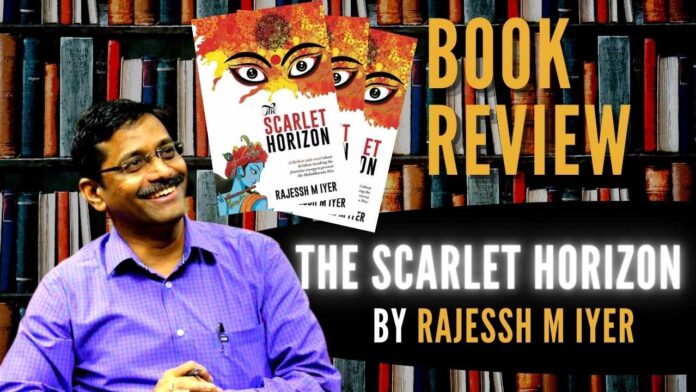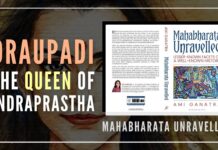
The Scarlet Horizon: A new dimension to Mahabharata
The mere mention of The Mahabharata invariably brings to mind differences, war, massacre, and destruction… and the men embroiled in them. Though there’s no denying strong women and their contribution to this saga, the men are at the epicenter of this epic. The thought of women holding center stage in the great epic seems far-fetched. Till you read ‘The Scarlet Horizon‘.
The Scarlet Horizon by Rajessh M Iyer takes a different stance on the Mahabharata, where the women are elicited to hold the cudgel to stop the cataclysm. Those familiar with the epic know of Krishna’s attempts to stop the war. However, in this story, he also does this by talking to Mahabharata’s most influential female characters, much to the surprise of men, who have no clue about his intent. So apart from discussing the matter with King Dhritarashtra and Regent Prince Duryodhan, Krishna speaks to ten women, who he knows would be impacted the most if the war takes place. These women are Lakshmana (Krishna’s daughter-in-law and Duryodhan’s daughter), Draupadi (Pandavas’ wife), Bhanumati (Duryodhan’s wife), Gandhari (the Kuru kingdom queen), Arshi (Shakuni’s wife), Ponnuruvi (Karna’s wife), Kripi (Drona’s wife), Sulabha (Vidur’s wife), Kunti (Pandavas’ mother) and Uttara (Abhimanyu’s wife). Krishna’s hopes hinge on these women. He knows that women have the power that even men lack. They have the power to save the planet from a disaster and change the course of humanity. He feels they must do so since it’s these women who would bear the brunt of the war more than the men waging it. However, he rues that such an understanding eludes most. Little wonder Krishna states that patriarchy exists not just among men but holds a firm place in women’s minds too!
The book profoundly dwells on Krishna’s attempts to evoke feminine energy and bring forth the resilience deep-seated within these women.
The Scarlet Horizon, as the name suggests, is about dreadful impending tints that create a palette in the sky, a clear sign of nature expecting humans to respond. Manifold mysteries unfold in the sky, shrouded on a vast canvas for everyone to see.
The book is about Sri Krishna’s efforts to evoke feminine energy, enabling women to realize their latent potential. Like in Shaktism — where the primordial energy is represented as a female force — the author beautifully portrays the woman’s power as she is the only one who is blessed to be the mother, the root of creation and preservation. The book speaks of raising the feminine energy, the divine power from within to stop the mayhem. Shakti is dormant and has to be awakened by various yogic and other practices, raised from the lowest chakra to the highest one. Krishna makes a similar yogic endeavour to evoke that energy to quell the apparent war.
As the story evolves, the author introduces us to the Dasa Mahavidyas, the ten wisdom goddesses or forms of Shakti. They are the goddesses of great knowledge, with maha meaning great and vidya meaning knowledge. The basic configuration of Devi in Hinduism covers a whole range of feminine divinity, encompassing dreadful goddesses at one end to the ravishingly beautiful and docile at the other. They are believed to be the ten cosmic powers of the universe or the ten insights covered by ten mysteries about ten elemental energies, which are personified as goddesses and depicted brilliantly as offering darshan to the ten most potent woman characters of the epic.
The ten goddesses are Kali, the goddess of eternal night, of destruction and time; Tara, the goddess who guides through troubles; Tripura-Sundari, she who is lovely in the three worlds; Bhuvanesvari, she whose body is the world; Chinnamasta, the goddess who self-decapitates; Bhairavi, the fierce one; Dhumavati, the widow; Bagalmukhi, the paralyzer; Matangi and Kamala the goddess of speech, knowledge and wealth.
Although some goddesses in this group are considered important as individual goddesses and can be traced back to an earlier time, the group is a medieval expression of an aspect of Mahadevi theology.
Shakti is power and energy in both dynamic and static forms. Every possible thing and action in the universe arises from, exists in, and eventually returns to the primordial Shakti pool. Absolute, immutable, enduring, all-pervasive consciousness is the bedrock upon which the universe stands, and our cosmos and all conceivable cosmoses assemble themselves on it from the substance and dynamism of Shakti.
The book is a message to women, who need to realize their power and draw out the divine exemplar that is indeed a symbol of their supreme ability and not be subservient to deep-seated traditions that lean on patriarchy.
The author has skilfully depicted Krishna’s angst while trying to set Dharmic order. Krishna wants the pivotal characters to acknowledge their ability entrenched in them and draw from it to chart the course of history. He wants them to realize that languor on their part would lead to catastrophic consequences. Unfathomable astral events unfold on the night of invocation, as the goddesses, in various representations, emerge on the scarlet-swathed firmament, waiting for human response. However, what needs to be seen is if these women come out of their state of inertia.
The book should be read to fathom the expectations the divine energy has with women and also to understand the dismal disconnect most have with the inherent spark. It is a must-read, particularly in today’s world, where voices about women’s empowerment are rising.
Note:
1. Text in Blue points to additional data on the topic.
2. The views expressed here are those of the author and do not necessarily represent or reflect the views of PGurus.
PGurus is now on Telegram. Click here to join our channel and stay updated with all the latest news and views
For all the latest updates, download PGurus App.
- The Scarlet Horizon: Sri Krishna and the feminine energy he believed could stop the war! - March 2, 2023
- ‘Jabberwockiers’ book review: Tender yet Turbulent - March 9, 2022
- An audience with Anant Pai in the true sense… - August 14, 2021










